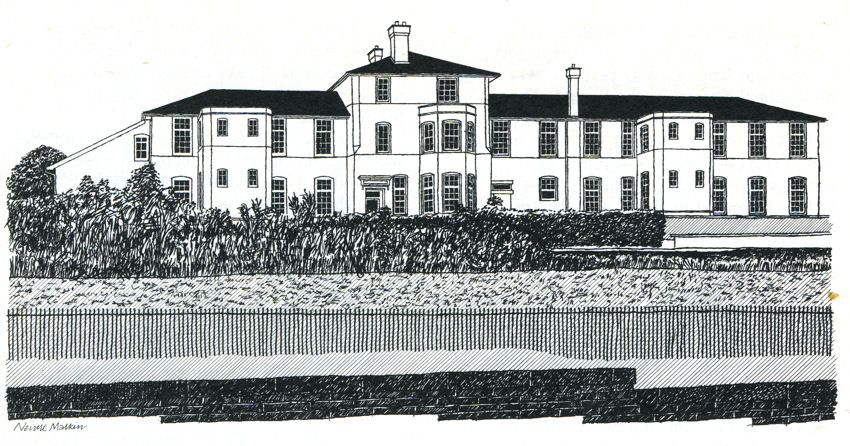|
|
|
![]() back to "The Grand Tour" index
back to "The Grand Tour" index
Neville Malkin's "Grand Tour" of the Potteries
buildings South of the Potteries
![]()
![]()
![]()
next: Holy Trinity
Church, Newcastle
previous: Victoria
Theatre, Hartshill
contents: index of
buildings south of the Potteries
|
No 20 - City General Hospital, Newcastle "About 1870 more additions were made to the Hospital Branch, when the "New Hospital" (now known as the Infirmary) was opened. This had a holding capacity of 145 persons, together with the necessary staff of nurses, &c. These arrangements sufficed for about 14 more years, up to 1884, when a hospital for female inmates and one for males was added, together with a large building between the two departments used for kitchen and laundry purposes. These new wards can comfortably house 165 sick, and by their addition the Master was able to classify his cases. The "New Hospital" was then named the Infirmary, and all chronic cases were dealt with there, and in the new hospitals were placed the acute cases. This arrangement is the same to-day, and the first Hospital (1842) has been altered to accommodate, in a very crowded manner, 130 old men. (It is really only large enough for 80). When a person desires to enter the workhouse as an inmate, (not casual), having received his (or her) proper form of admission, he is taken first of all to the new receiving ward. Here his clothing is taken away, thoroughly disinfected, and stowed away in case they may be required again. Then he is taken to an excellent, warm and comfortable bathroom, where a hot bath is given, after which a night-gown is supplied and the applicant is shown to a good bed, in a room where about twelve can be accommodated, First thing in the morning he is examined by the doctor, and on that gentleman's certificate is placed in whatever department he is fitted for. He is now on probation, and at the next following meeting of the Guardians his case is gone into; and if found deserving, he is allowed to stay in the house; if not, the alternative course is taken." from an Almanac of 1902 |

City General Hospital,
Newcastle
pen drawing by Neville Malkin - Nov 1974
| Note: Neville Malkin's notes (below) state that the building in the sketch was erected in 1842 - this is incorrect - it was the original school house and parish hospital that was built in 1842 and the building in the sketch was a new hospital built in 1884. |
|
"This building, erected in 1842 and originally known as the Parish Hospital, represents only a small part of the giant complex known today as City General Hospital. The first buildings on this site were constructed in 1832 and served as the workhouse. Previously the Stoke Parish Workhouse was situated in the village of Penkhull, but the increasing number of destitutes requiring accommodation and assistance necessitated the building of much larger premises which would contain at least 500 inmates. These were built at a place called the Spittals, about half-a-mile south of Newcastle, at an outlay of £3,000, with a further £3,000 spent on various installations. The finished institution was completely self-contained, with its own bakery, laundry, workshops and accommodation. Discipline was very strict, and a variety of punishments inflicted upon offenders. The inmates would rise at 5.45 a.m. and retire after a hard day's work at 8 p.m. Meals were just adequate but very stodgy, and no talking was allowed during meal times. The sexes were segregated; even husbands and wives were separated. If there were any children they would be removed to a nearby orphanage. In fact, on many a birth certificate the place of birth appeared as 578, Newcastle Road, Stoke-on-Trent. This was an adopted address intended to disguise the place of birth, which would otherwise have been The Workhouse. In later years, the name was changed from the Spittals Workhouse to the London Road Hospital and Institution, and continued as such until 1945 when it became City General. The actual workhouse appears to have been phased out during the last war, at a time when extra accommodation was needed for the war injured. It is thought that some centuries earlier a hospital called St. Loyes occupied this same site but there does not appear to be any real evidence to substantiate this theory."
|

The 1884 hospital
|
This is the rear of the building in Neville Malkin's sketch - it has been mostly absorbed into a modern extension and so the frontage is no longer in existence, however similarities can be seen between the photo and the sketch. |
|
"This was arranged to hold about 80 patients, and was found a very valuable addition to the Workhouse."
"...... it was found that a School was very necessary, as the number of child inmates had grown considerably; so in 1866 a School, capable of accommodating about 250 scholars, was opened and used until some three or four years ago, when the Guardians decided that the youngsters should attend the Board Schools."
"No particular form of religion is forced upon the inmates. The Roman Catholics arc allowed to attend the Newcastle Catholic Church. The Dissenters hold divine worship in the Workhouse Chapel, each Sunday morning, this Chapel being a separate edifice used entirely for religious services; and the members of the Church of England attend service in the Chapel each Sunday afternoon and Wednesday evenings. The Rev. J. Edwards is the paid Chaplain." from an Almanac of 1902 |
next: Holy Trinity Church, Newcastle
previous: Victoria Theatre, Hartshill
contents: index of buildings south of the Potteries
back to "The Grand Tour" index